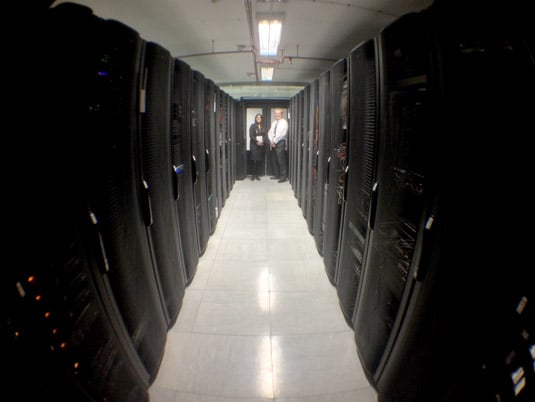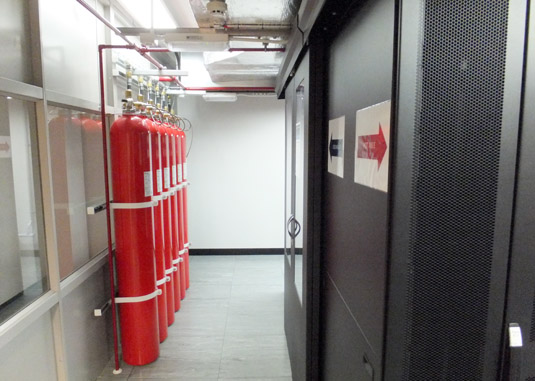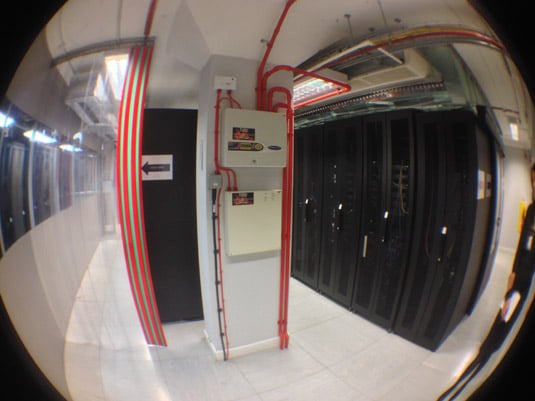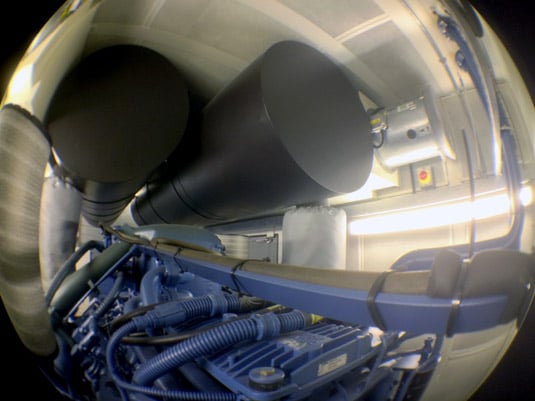This article is more than 1 year old
Hot racks and cool customers: Colocating in the capital
Where diesel, data and dark fibre meet
Blowing hot and cold
Suites aside and fingerprints permitting, you can enter the more open equipment rooms. In a slightly older area, the floor space is taken up with half racks and quarter racks – mostly low power, although the air conditioning still rages. In the more critical areas, City Lifeline takes a hot aisle, cold aisle approach to cooling.
“Here we have the hot aisle as the general area outside, and this is the cold aisle here, other people run it the other way round,” explains Keenan as we step into the chilled chamber of racks, the alarm bleeping away – a shrill reminder to visitors to keep the sliding door shut.

Inside the cold aisle: alarms sound to remind visitors to keep the door closed
“We keep a relatively small floor void with all the power and signal cabling underneath the floor, separated, with all the air handling above. The basic idea is cold air falls into the cold aisle, it goes through all the equipment, it’s heated, and vents into the hot aisle. The hot air rises, goes into the evaporators, cools, and is blown back down across the top of the racks, falls into here and goes right round in a circle.”
Eyeing the equipment items, Keenan points out a couple of items of rack gear and remarks, “A specialised telephony company looks like that now. Ten years ago, that would have been a private suite. Back then a voice telecoms operation needed all sorts of specialised TDM [time division multiplex] equipment and every voice operation needed at least a full rack of kit, often more."
"TDM has largely gone now, and most voice telephony is carried as TCP/IP packets on VoIP (voice over internet protocol). You can run a voice network in a quarter rack on two standard servers plus a router. You need one server to do all the switching and the other to do all the billing, control and management around it. And the router to switch to the IP platform, plus all the software, but that’s all you need.
"You could even manage it all using one server and no router, but most wouldn't consider that to be a good design strategy. So nowadays, the colo requirement for a voice operation can easily be just a separately lockable quarter rack and 10Meg of IP, rather than a whole rack and miles of coax."

City Lifeline argonite gas and hot aisle
Alarming situation
Stepping into the hot aisle again, a line of six red argonite gas cylinders catches the eye in this, one of many, server rooms. There’s a set procedure for fire though. The building is 24/7 manned and if there’s any smoke, the VESDA system alarms security, which sends somebody up to investigate.
The standing instructions basically come down to: if there’s smoke coming out of a piece of equipment, pull all the bank’s plugs out and contact a supervisor. In what would most likely be an isolated incident, this approach would cover most scenarios. If all else fails, the gas floods the area to extinguish a fire, but is operated manually by security. You can’t have folk in these areas when the gas goes off as they would suffocate.
Keenan recalls a fire hazard of a different sort that City Lifeline had to deal with. “A long, long time ago, we used to have a customer whose engineer would go to the pub at lunchtime and come back pissed at 4 o’clock. He’d say he was perfectly all right, and then go round the back of the equipment and fall asleep. We always said to him: what happens if there was a fire and somebody came in shouting if anyone was in there and he was asleep and then let the gas off?“ A sobering thought, but it’s all changed now. If you’re boozed up, City Lifeline’s security won’t let you in.

Dream machines? Hot aisle hiding places perfect for a boozy snooze
Tricky customers
There are other reasons for not being let in at all at City Lifeline. While Keenan is pleased to report that he can’t recall any troublesome clients, there are always exceptions and he knows the customers well.
Naturally, there’s an acceptable use policy in place for those who rely on the site’s IP. If other clients were affected by the antics of a particular customer, they’d get disconnected. He admits, those involved in scammy phone behaviour haven’t affected other users, but he’s had no cause to disconnect anyone, but wouldn’t hesitate to do so if it was appropriate.
He concedes that you never refuse customers, instead you declare that the required services aren’t available or you double the price, as there are some outfits whose reputations precede them as being “not nice people” which sounds intriguing. So how "not nice" is not nice?
“Shall we say, the kind of people who if you asked them to pay a bill and they didn’t want to, might break your legs. There are some of those around. About 10 years ago and all through the dotcom boom there was a lot of ‘wild west’ stuff around like that. It’s pretty well all gone now. The cowboys all went out of business, went bust and were replaced by professional companies who knew what they were doing and did things properly.”
Special ops
As we wander around the facility, five tech ops are busy checking out alarms, aircon equipment and power to server rooms; communicating their findings on walkie talkies. City Lifeline Operations Manager Bill Walsh orchestrates the proceedings as today is the monthly generator test, when the power is switched over from the mains – that keeps the UPS batteries charged – to the one of the two diesel generators. He explains the procedure.

Diesel generator with massive black silencers above it
“We have workshops regularly with my team to go through the electrical schematics. That ensures everyone is aware of who should be switching when. During the switchover, the team is deployed in different parts of the building. However, the first thing we do is make sure the generators are all working, make sure they’ve got fuel. One in duty, one in standby and every month we swap them over. We also run generator tests every week. They are run off-load for 10 minutes because if you run them for any longer off-load, they don’t like it, they coke themselves up. They're designed to be run on load.”
And today’s the day when one of the 30 litre V16 generators is taking the strain. The switchover happened as I chatted to Keenan in the boardroom and the only way to tell was the building lights went out, as they rely on mains power and only back-up lighting would kick in.
The actual client equipment is always fed by the banks of UPS lead-acid batteries producing what Keenan refers to as “synthetic mains” and we went along to the UPS area where these batteries were hard at work.
